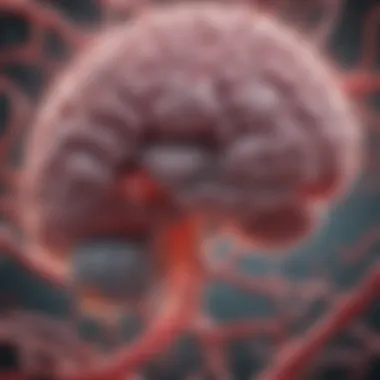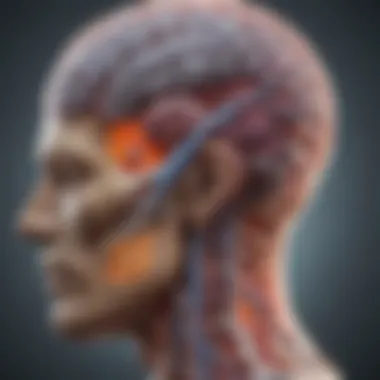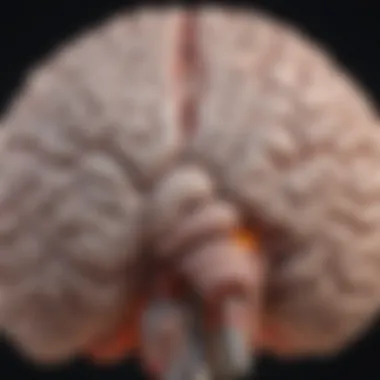Linking Lung Cancer to Brain Tumors: Insights and Impacts


Intro
Lung cancer is a relentless adversary in the realm of oncological diseases, often becoming a public health crisis. Yet, what may not garner as much attention is how this insidious condition can also impact other vital organs, particularly the brain. Understanding this connection is crucial for various stakeholders, from researchers to healthcare providers.
Brain tumors can arise in several forms, with many cases linked to metastasis from primary cancers elsewhere in the body. It is against this backdrop that the relationship between lung cancer and brain tumors unfolds, unveiling a labyrinth of biological interactions, clinical implications, and patient outcomes. This article aims to shed light on the nuanced pathways through which lung cancer can migrate to the brain, emphasizing both the mechanics of this process and the significance it holds for those affected.
Prolusion to Lung Cancer
Lung cancer is a malady that has significant implications not just for the lungs but for the body as a whole. It's one of the leading causes of cancer-related deaths globally. Understanding lung cancer is vital for grasping how it can manipulate other bodily systems, particularly in the context of its potential to metastasize to destinations like the brain. This article highlights how lung cancer operates and reasons behind its prevalence, aiming to shed light on the connections in the medical landscape.
General Overview
Lung cancer manifests when abnormal cells in the lungs grow uncontrollably, forming a tumor. This abnormal growth can be classified primarily into two categories: non-small cell lung cancer (NSCLC) and small cell lung cancer (SCLC). Each type presents its own challenges and implications.
Understanding these differences is crucial; it affects everything from diagnosis to treatment options. Given that lung cancer can migrate and impact other organs like the brain, discerning the particulars become even more imperative in clinical practice.
Types of Lung Cancer
Non-Small Cell Lung Cancer
Non-small cell lung cancer is the most widely recognized form of lung cancer, accounting for approximately 85% of all cases. The primary aspect here is its three main subtypes: adenocarcinoma, squamous cell carcinoma, and large cell carcinoma. These variations reflect not only the cells involved but also influence the growth patterns and how the disease progresses.
A key characteristic is that NSCLC typically grows at a slower pace when compared to its small cell counterpart. This can sometimes provide more opportunities for intervention, whether through surgery or systemic therapies.
Unique to NSCLC is its responsiveness to targeted therapeutic drugs. This is particularly relevant in the age of personalized medicine. However, the complexity of tumor genetics can lead to complications in treatment and outcomes.
Small Cell Lung Cancer
Small cell lung cancer, in contrast, accounts for about 15% of lung cancer cases and is often linked to extensive tobacco use. At its essence, SCLC is known for its rapid growth and early spread to distant sites in the body, making it a more aggressive player on the cancer stage.
A significant characteristic of SCLC is the high level of neuroendocrine markers, which sets it apart in terms of both biology and treatment responses. Typically, SCLC is treated aggressively with chemotherapy and radiation due to its tendency to metastasize swiftly.
This aggressive nature makes it a focus of studies examining how lung cancer can affect other organs, such as the brain. The patterns of spread from lung to brain also yield insights into how integrated treatment strategies, including the possibility of neurosurgical interventions, can arise.
Risk Factors for Lung Cancer
Tobacco Use
Tobacco use remains the most significant risk factor associated with lung cancer, accounting for a staggering 85% of lung cancer cases. The specifics here are glaring: the longer the history of smoking, the greater a person's risk of developing lung cancer. This link isn't just a fluke; it’s a direct correlation borne out in countless studies.
The detrimental chemicals in tobacco smoke cause constant damage to lung tissue, leading to mutations. As a choice for discussion, tobacco use underlines why smoking cessation programs are fundamental in cancer prevention strategies and health campaigns.
Environmental Exposures
Environmental exposures involve a range of potentially hazardous substances. From radon gas to air pollution and occupational hazards, these factors have been shown to play a significant role in increasing lung cancer risk. Notably, many of these exposures are out of the direct control of individuals.
For instance, continuous exposure to asbestos in the workplace can lead to a drastically heightened risk. Here, the unique feature is the cumulative nature of exposure - the effects can build over time, leading to delayed manifestations of the disease. Understanding these nuances is vital for implementing public health initiatives aimed at reducing exposure.
Genetic Predispositions
Genetic predispositions provide another layer to the risk factors. Individuals with a family history of lung cancer may carry specific genetic markers that heighten their risk. This adds a complex dimension to the conversation around lung cancer that involves both inherited and environmental factors.


Unique to genetic predispositions is the awareness of heritable mutations that predispose individuals not just to lung cancer, but also potentially to other cancers. This relationship emphasizes the importance of genetic counseling and screening in at-risk populations. Understanding such factors offers pathways for targeting therapies and creating personalized treatment approaches.
Understanding Brain Tumors
Understanding brain tumors is crucial when examining the intricate relationship between lung cancer and how it can metastasize to the brain. This section sheds light on two major types of brain tumors—primary and secondary (metastatic)—as well as their clinical symptoms. By gaining insights into these elements, we're better equipped to comprehend the challenges faced by patients and the implications of lung cancer spreading to the brain.
Knowledge of brain tumors helps medical professionals devise appropriate treatment strategies and offers patients a clearer picture of what they face. Most notably, understanding the particulars surrounding these tumors can also impact mental health and provides a sense of empowerment for those grappling with diagnoses. Here’s an in-depth look at the two main types of brain tumors, as well as their symptoms.
Types of Brain Tumors
Primary Brain Tumors
Primary brain tumors originate within the brain itself and can arise from various types of brain cells. The significance of primary brain tumors is marked by the fact that they encapsulate a diverse range of tumor types, some of which can be benign while others may have malignant characteristics.
A key characteristic of primary brain tumors is their ability to infiltrate surrounding brain tissue, complicating treatment options. These tumors often develop from different cell types, such as glial cells, which form the supportive tissue of the brain. For instance, gliomas are considered a common subtype, and their unique feature is the potential for aggressive behavior, making them a focal point in research.
The advantages of understanding primary brain tumors lie in the potential for targeted therapies, although challenges remain in effectively managing their complex nature.
Secondary (Metastatic) Brain Tumors
Secondary brain tumors, often referred to as metastatic, originate from cancer cells that travel to the brain from another organ, such as the lungs. These tumors represent a critical aspect of the conversation surrounding lung cancer, as many patients develop brain metastases as the disease progresses.
A defining characteristic of secondary brain tumors is their source; they are not primary tumors, which poses additional challenges for diagnosis and treatment. The unique feature here is the rapid growth rate often encountered with metastatic tumors, making early detection essential. As lung cancer is one of the most common origins of brain metastases, understanding this connection is fundamental.
The major advantage of recognizing metastatic brain tumors early on is the timely intervention that may prevent further complications, thereby improving the patient's overall quality of life.
Clinical Symptoms
Understanding the clinical symptoms associated with both primary and secondary brain tumors is vital for early diagnosis and effective treatment. Symptoms can vary greatly, depending on the tumor's location, size, and growth rate.
Neurological Symptoms
Neurological symptoms are often the first sign that something is amiss when brain tumors are present. Common symptoms include headaches, seizures, or changes in vision and coordination. The catch here is that these symptoms can overlap with those of other medical conditions, making diagnosis tricky.
The key characteristic of neurological symptoms is their potential to significantly affect daily life. They serve as indicators of underlying issues that might warrant further investigation. The unique feature of these symptoms lies in their variability; different tumors may present differently, complicating the diagnostic process and necessitating a tailored approach to treatment. Knowing these symptoms can lead to quicker responses from healthcare providers, enhancing patient outcomes.
Cognitive Impairment
Cognitive impairment presents another layer of complexity when it comes to brain tumors. Patients might experience difficulties with memory, attention, and problem-solving skills. This aspect is particularly significant because it can greatly affect a person’s quality of life.
A defining feature of cognitive impairment is its gradual onset; many individuals might not immediately recognize their symptoms as being related to a brain tumor. It can lead to delays in diagnosis and treatment. The unique aspect of cognitive issues is that they may not only stem from the tumor itself but also from treatments like chemotherapy and radiation therapy.
Understanding cognitive impairment is thus essential not only for monitoring patients but also for shaping supportive therapies that can ease these challenges.
Awareness of symptoms and their timely evaluation can make all the difference in patient outcomes when it comes to brain tumors.
In sum, unraveling the complexities of brain tumors and their symptoms is essential to understanding how lung cancer spreads to the brain. As we forge ahead, dissecting these elements enables a more nuanced conversation about treatment and care.
Mechanisms of Metastasis
Understanding how lung cancer can metastasize to the brain is crucial in unraveling the complexities of both malignancies. The process of metastasis, which is the spread of cancer cells from the primary tumor to other parts of the body, including the brain, is not just a random affair. It involves intricate biological pathways and environmental factors. These mechanisms not only shape the prognosis and treatment plans but also aid in developing preventive strategies for patients at risk. With brain metastasis being a significant concern in lung cancer patients, delving into these mechanisms helps clinicians and researchers work toward more effective interventions.


Biological Pathways
The biological pathways underlying metastasis can be quite elaborate. Several factors contribute to how lung cancer cells travel from the lungs to take up residence in the brain. Some primary biological mechanisms involve the extravasation process, where cancer cells escape from the bloodstream and invade surrounding tissues. Here's a closer look at some of these pathways:
- Cell Adhesion Molecules: These molecules play a vital role in helping cancer cells stick to the endothelial cells lining blood vessels. Once these cells adhere, they can penetrate the vessel walls and enter the brain tissue.
- Matrix Metalloproteinases (MMPs): These enzymes are responsible for degrading extracellular matrix components. Cancer cells often produce these MMPs to break down barriers that might prevent them from spreading into new environments, such as the brain.
- Growth Factors: Certain growth factors, such as Vascular Endothelial Growth Factor (VEGF), are produced by tumors. VEGF can promote new blood vessel formation, facilitating the delivery of cancer cells to distant sites, including the brain.
In understanding these pathways, researchers are developing therapies that target specific components involved in metastasis. By blocking these pathways, there’s potential to impede the spread of cancer cells, giving patients more hope.
Influence of Tumor Microenvironment
The tumor microenvironment also plays a pivotal role in the metastasis of lung cancer to the brain. This microenvironment consists of various non-cancerous cells, extracellular matrix components, and signaling molecules that can interact with the cancer cells. Key elements include:
- Inflammatory Cells: Research indicates that inflammatory responses can aid in the establishment of metastases. These cells can produce signaling molecules that support the survival and growth of cancer cells after they have migrated to the brain.
- Hypoxic Conditions: Tumors often develop in low-oxygen environments (hypoxia), which can further accelerate metastatic potential. Hypoxic conditions can stimulate the expression of genes that promote survival and resilience in hostile environments, making it easier for cancer cells to thrive in the brain.
- Stromal Cells: The interaction between cancer cells and different types of stromal cells—including fibroblasts and immune cells—can influence the metastatic cascade. These stromal cells can either support or inhibit cancer progression, depending on their function and the signals they produce.
"Metastasis is not merely a consequence of cancer progression; it's a complex interplay of biological processes and environmental factors that can dictate a patient's journey."
Through ongoing research and innovative approaches, there is a concerted effort being made to target these pathways, hopefully leading to enhanced survival rates and improved quality of life for those battling these daunting conditions.
Clinical Implications of Lung Cancer Spreading to the Brain
Understanding how lung cancer can spill over into the brain carries significant weight, shedding light on both the complexities of the disease and the pathways leading to serious health consequences. When lung cancer metastasizes to the brain, it’s not just a matter of a secondary tumor forming; it complicates the patient’s clinical picture significantly. This interaction showcases urgent needs for effective diagnostics and tailored treatment strategies.
The connection between lung cancer and brain tumors provides insight into the various symptoms patients might experience—ranging from persistent headaches to severe cognitive changes. The implications go beyond the physical; they also touch on the emotional and psychological well-being of patients and their families, making it crucial to address not only the medical aspects but also the support they might require.
Diagnostic Techniques
MRIs and CT Scans
Both MRIs and CT scans serve as foundational tools in the diagnostic process for patients suspected of having lung cancer with potential brain involvement. The key characteristic of these imaging techniques lies in their ability to provide detailed images that can reveal the presence and extent of metastases.
MRIs are particularly valuable because they utilize strong magnetic fields and radio waves to capture clear images of the brain and its surrounding structures. This non-invasive approach is beneficial as it allows for detailed visualization of soft tissue, offering a clearer view of brain abnormalities that might arise due to lung cancer. On the other hand, CT scans can quickly offer cross-sectional images, providing a swift option when time is of the essence in diagnosing critical conditions.
However, each has its unique aspects; for instance, while MRI offers higher resolution images, it does take longer and is more expensive than CT scans which are quicker but may not capture finer details. This interplay between cost and efficacy makes them both valuable yet distinct tools in the diagnostic toolkit.
Biopsies
When imaging indicates potential tumors, biopsies provide a definitive means of identifying cancer cells. The significance of biopsies in this context is paramount; they offer concrete evidence to ascertain whether the cancer has indeed spread to the brain. A biopsy allows for tissue sampling, which can then lead to specific treatments based on the cancer’s type and characteristics.
The primary advantage of biopsies is their ability to confirm the diagnosis. This not only solidifies the treatment plan but also helps in understanding prognosis. However, biopsies do come with their drawbacks, including the risks involved in the procedure and possible complications from the sampling. The consideration of these risks is essential, as patients may have varying health conditions that affect their ability to undergo invasive procedures.
Treatment Strategies
Surgery
Surgery can play a critical role when treating brain metastases from lung cancer. The main goal is to remove as much of the tumor as possible, which could alleviate symptoms and improve the quality of life for patients. The key aspect of surgery is not only to treat the tumor but also to provide insights into how the cancer behaves, which is crucial for future treatment decisions.
Despite its advantages, surgery comes with inherent risks, including infection and complications related to anesthesia. Furthermore, the extent of tumor removal may be limited depending on the tumor's location and its interaction with vital brain structures. Thus, while offering potential for significant benefits, the decision to proceed with surgery should be made on a case-by-case basis.
Radiation Therapy
Radiation therapy has become a cornerstone treatment for patients dealing with brain metastases. It serves a dual purpose—acting either as a primary treatment or as an adjunct following surgery. The key characteristic of radiation therapy lies in its ability to target cancer cells selectively while sparing surrounding healthy tissue.


One notable feature of radiation therapy is its non-invasive nature, making it a popular choice for those who may not be candidates for surgery. However, side effects such as fatigue and changes in cognitive function can affect patients post-treatment. The potential for long-term effects necessitates careful patient monitoring and discussions about quality of life.
Chemotherapy
Chemotherapy represents another treatment strategy that could be employed when lung cancer spreads to the brain. By using systemic medications, this approach works to target cancer cells throughout the body, including the brain. A significant advantage of chemotherapy is its potential to address any residual cancer that might remain after other treatments.
Nevertheless, chemotherapy can often lead to adverse side effects such as nausea, fatigue, and susceptibility to infections. The delicate balance of managing these effects while ensuring adequate treatment for the cancer requires a tailored approach for each patient.
Prognosis and Outcomes
The impact of lung cancer spreading to the brain on prognosis and patient outcomes is profound. Factors like the number of brain metastases and the overall health of the patient come into play, influencing survival rates and response to treatment. Generally, earlier detection and intervention can lead to improved outcomes, underscoring the importance of ongoing research and clinical awareness.
Ultimately, understanding the clinical implications when lung cancer affects the brain will guide healthcare professionals toward comprehensive care strategies tailored to patients’ unique needs, combining the latest in diagnostic techniques with a nuanced approach to treatment.
Research Developments in Lung Cancer and Brain Tumors
The relationship between lung cancer and brain tumors has drawn considerable attention in recent years. Understanding this complex interplay helps to underscore the pressing need for continuous research. By investigating the mechanisms by which lung cancer spreads to the brain, researchers are uncovering critical insights that may lead to enhanced diagnostic tools and more effective treatment strategies.
Key developments in this realm are guiding clinical practices and shaping future therapies. Improved understanding not only aids in early detection but also enriches our grasp of patient prognosis. With lung cancer being one of the primary causes of cancer-related deaths worldwide, exploring new avenues for research is essential.
Recent Advances in Research
Recent advances in this field have paved the way for numerous breakthroughs. Studies utilizing advanced imaging technologies are becoming common. For instance, high-resolution MRI scans have significantly improved the accuracy of detecting metastasis in the brain. Innovations like machine learning algorithms are also being applied to analyze imaging data more effectively, allowing clinicians to spot tumors that might have escaped human eyes.
Moreover, recent molecular research has revealed specific biomarkers associated with lung cancer types, that may determine their likelihood of spreading to the brain. These findings offer promises in personalizing treatment plans, tailoring approaches based on individual patient profiles. Consequently, optimal therapeutic strategies might be devised, ultimately leading to better outcomes.
Future Directions
The future holds numerous possibilities to enhance our understanding and treatment capabilities regarding lung cancer and brain tumors. Efforts are focusing on developing novel therapeutic approaches and targeted treatments, both of which contain unique elements that could drastically improve current modalities.
Novel Therapeutic Approaches
Novel therapeutic approaches involve experimenting with cutting-edge treatments that are still in the pipeline. These could range from gene therapy to immuno-oncology. In particular, expanding the use of immunotherapies could tap into the body's innate mechanisms to fight cancer more effectively. One key characteristic here is their ability to adapt to the ever-evolving nature of tumors, a pivotal feature amid the changing landscape of tumor biology. Because of their adaptability, these therapies are gaining traction among researchers looking for sustainable long-term solutions.
However, it is important to note that many of these approaches are experimental. Their efficacy and safety are still under scrutiny as clinical trials continue.
Targeted Treatments
Targeted treatments are gaining momentum as a significant aspect in the fight against lung cancer, especially when it metastasizes to the brain. These therapies focus on specific genetic mutations found in tumors, allowing for more precise interventions. A key characteristic of targeted treatments is their ability to limit damage to healthy cells, generating a considerable advantage over traditional chemotherapy. By honing in on cancer cells, these therapies can often yield better results while minimizing side effects.
"In the field of cancer research, a coherent approach integrating both molecular biology and clinical feedback is paramount to make real strides toward effective treatments."
Continued exploration of these avenues holds the potential for monumental shifts in how we approach lung cancer and its complications, especially concerning brain tumors. As researchers and clinicians collaborate more closely, the ultimate goal is to provide patients with tailored strategies that enhance their quality of life while effectively managing these complex conditions.
Epilogue
The intricate link between lung cancer and brain tumors reverberates throughout medical research, impacting diagnosis and treatment approaches. With the information gathered, it's evident that understanding this connection is paramount for improving patient outcomes and offering tailored medical interventions.
Summary of Key Points
This article highlights several critical aspects of lung cancer and its potential to metastasize to the brain. By delineating the types of lung cancer and the biological mechanisms through which these tumors spread, we underline a pressing concern in oncology.
- Types of Lung Cancer: Knowing the classifications, like Non-Small Cell Lung Cancer and Small Cell Lung Cancer, is vital as these dictate prognosis and treatment.
- Mechanisms of Metastasis: Delving into the pathways that enable lung cancer to migrate to the brain emphasizes the need for targeted treatments.
- Implications for Patient Care: Effective diagnostic techniques such as MRIs and CT scans play a pivotal role in early detection, which can significantly influence treatment success.
The above points serve to stress the interplay of factors that need to be addressed urgently in clinical settings.
The Importance of Continued Research
As we wrap up, it’s essential to emphasize the significance of ongoing research in this sphere. Identifying novel therapeutic approaches and targeted treatments can pave the way for advancements in the fight against these life-altering conditions. Continuous research not only enhances our understanding but also facilitates the development of effective strategies to manage the symptoms and improve the quality of life for patients facing these formidable challenges.
With the right emphasis on research, we could very well stand at the precipice of breakthroughs that transform treatment modalities, making a lasting impact on both patient survival and overall well-being.



